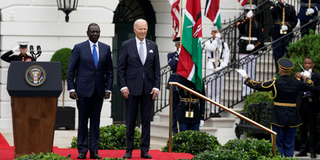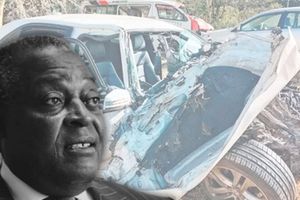Premium
What American goodies from the Ruto state visit mean to Kenyans

U.S. President Joe Biden welcomes Kenyan President William Ruto during an official White House State Arrival ceremony on the South Lawn of the White House in Washington, U.S., May 23, 2024.
May 2024 will go down in history as Kenya pivoted decidedly to the US and the West more broadly.
This is not new. Save for the 2008-17 interregnum, Kenya has been more West than East-inclined. The phrase “choices have consequences” crafted in Washington during the 2013 Kenyan elections denoted the lowest ebb of Kenya-US ties. The new turn West is marked by a tectonic shift in depth and breadth not witnessed in Africa in recent times. Latching on to the symbolism of 60 years of official relations, the US rolled out a state visit in Dr Ruto’s honour. A glamorous dinner, a 21-gun salute and joint press conferences confirmed the elevation of relations.
Perhaps the most significant symbolic gesture was the designation of Kenya as “a Major Non-NATO Ally”, a first in Sub-Sahara.
Cumulatively, these soft power projections create an environment in which Kenya is co-opted into the Western sphere in an increasingly multipolar world. However, one must count the money to appreciate the US’ entreaties towards Kenya. Analysts will be poring over the deals. The most authoritative, publicly accessible source is a fact sheet released by the White House on Thursday.
Three approaches can be used to make sense of the hefty financial outlay rolled out to cement the relations. First are the legacy financials, those that had already been announced before the visit. Second is the money assigned, allocated or allotted and firmly announced.
Loans and grants
Third are pledges and commitments. Experience has shown that promises are uncertain as they are prone to shifting dynamics. This is because many such commitments are “intended” and subject to approval by Congress. It is often uncertain that Congress would endorse such commitments. Moreover, one must reckon with the possibility that Mr Biden might not be an occupant of 1600 Pennsylvania Avenue NW in Washington, DC address after the November elections. Separating the funding into these categories helps nail the bag of goodies that Dr Ruto brought home, those that were already in the bag, and the promissory funding that remains uncertain. A challenge for any analyst is that some announcements are unclear. Some are for regional projects, meaning Kenya-centric analysts would have to scrutinise what is in it for the country. Others are private sector-led rather than emanating from the US Federal sources.
Analysts will also have to distinguish between loans, grants and business-to-business deals.
Some of the financial announcements are for feasibility studies rather than direct project funding. Legacy funding examples include the US Trade and Development Agency’s (USTDA) $1.26 million funding of a feasibility study for internet connectivity. Legacy funding in health includes the $33.5 million anti-malaria contributed in 2023 and an estimated $12.9 million disbursed to the Kenya Medical Research Institute. These and many others were likely included to shore up the image of consistency and commitment by the US. It is with allocated funding that the US should be seen as walking the talk. Where is the money going? Democracy, governance and human rights top the bill: $40 million for overall programming, $2.7 million for civil society and $1.3 million for youth empowerment. Professionalising the police force is at $7 million while policy reforms targeting corruption come in at $2.7 million. The upshot is that the US is maintaining its foreign policy priority of good governance. Digital technology emerged as a key cross-cutting area of partnership.
Healthcare garnered $31 million leveraging a socalled “digital superhighway”. Electric vehicles and transport generally fall in the technology domain.
Here, Development Finance Corporation (DFC) announced $20 million in loans to two private sector-led projects tied to low carbon emissions. A further $1 million was allocated to enhancing Kenya’s carbon markets. Climate-related funding tells a story of success for Dr Ruto who has pinned his diplomacy on a foreign policy of climate change mitigation. Interestingly, the United States is relying on its private sector to lead the charge. In addition to the traditional use of the US International Agency for Development, these are the agencies the Kenyan business community would have to analyse closely. An example is a DFC loan of $51 million to M-Kopa, the Kenyan firm focused on asset financing targeting unbanked customers. Dr Ruto’s other foreign policy priority – reform of the international financial system – received a boost. The pledges of $21 billion to the International Monetary Fund’s Poverty Reduction and Growth Trust, and two separate pledges of $100 billion and $36 billion to the World Bank are cases in point.
Though they are pledges, they portend well for President Ruto’s campaigns around debt alleviation and sustainable financing.
Pending issues
The defence and security elements of the visit have chalked up analyses. The announcement of these donations is shrouded in a black box. Counter-terrorism and security matter received $18.7 million. However, this is a public-facing matter as the funds will be used to bolster rule of law issues of terrorism rather than combat matters. The many deals and pledges suggest we are about to witness a shift in Kenya’s diplomatic practice. Kenyan diplomats will be called upon to step up to the plate in implementing the many work-in-progress and pending issues that the phenomenal visit has unleashed. In a television interview during his visit, Dr Ruto dismissed the possibility of US-China geostrategic competition in Kenya. It is, however, evident that Beijing will have some catch-up to do considering the heft from Washington.
Kenyan strategists will have to develop a playbook to manage the rivalry.
Dr Wekesa heads the African Centre for the Study of the United States at the University of Witwatersrand and is a fellow at the University of Southern California and a visiting professor at Howard University.



